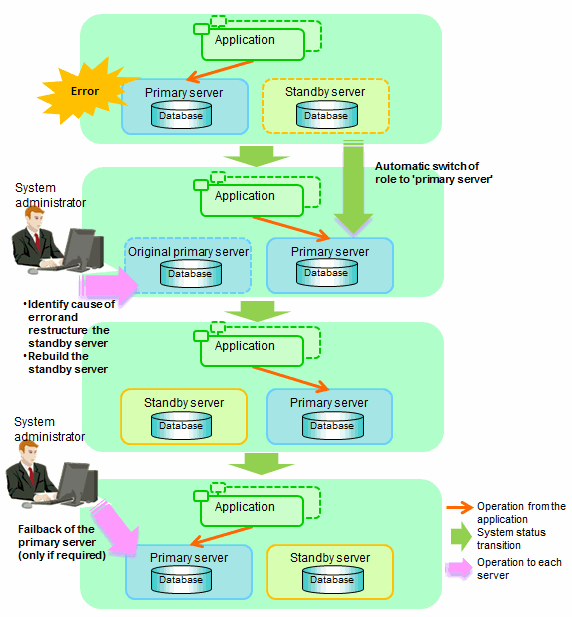This section explains the operations when the server has started degrading after a switch has occurred.
Note
After a switch has occurred as a result of an abnormality on the primary server, the database will not have a multiplexed configuration until the standby server is rebuilt. Remove the cause of the error as quickly as possible, and then rebuild the standby server.
If the reference job was executed on the standby server, and the servers are switched because an error occurred on the primary server, the load is concentrated on the new primary server. Accordingly, pause the reference job on the original standby server, rebuild the original primary server as the new standby server, and then resume the reference job for the new standby server.
If the instance on the new primary server is stopped before the original primary server where the error occurred is rebuilt as the new standby server, a split brain occurs at startup from the instance on the original primary server. Therefore, start the instance on the new primary server before rebuilding the standby server.
If the switch occurred and the server has started degrading, perform the following operations to recover the standby server and revert it to its original state:
Failback of the Primary Server (only if required)
The flow of these operations is shown in the figure below.
Figure 8.1 Flow of operations

Perform the recovery according to the following procedure:
Execute the mc_ctl command in stop mode for the original primary server on which the error occurred.
Example)
$ mc_ctl stop -M /mcdir/inst1
This also stops the instance that is required to perform the recovery.
Note
If the instance does not stop, refer to "Actions in Response to Failure to Stop an Instance" in the Operation Guide, and then stop the instance.
Then, specify the -e option in the above command to forcibly stop Mirroring Controller.
Copy the files in the Mirroring Controller management directory from the backup data, and then perform the recovery.
Refer to the system log of the primary server and the standby server to identify the cause of the error, and then perform recovery.
Execute the mc_ctl command in setup mode to perform recovery by synchronizing data in the original primary server with the new primary server.
Example)
$ mc_ctl setup -M /mcdir/inst1 -r standby -U userName -h primaryServerHostName -p primaryServerPortNumber --standby-name=standbyServerName
See
This recovery procedure is the same as the procedure for setting up the standby server.
Refer to "6.4.2 Creating, Setting, and Registering the Standby Server Instance", and then perform the recovery.
The starting of the recovered original primary server as the standby server is referred to as the "standby server rebuild".
On the original primary server, start Mirroring Controller and the instance.
As the instance administrator user, execute the mc_ctl command in start mode with the -f option specified. This enables automatic switch and disconnection.
If you start Mirroring Controller and the instance without specifying the -f option, automatic switch and disconnection will not be enabled. To enable both, start Mirroring Controller and then execute the mc_ctl command in enable-failover mode, or restart Mirroring Controller with the -f option specified.
Example)
$ mc_ctl start -M /mcdir/inst1 -f
As the instance administrator user, execute the mc_ctl command in start mode.
Example)
$ mc_ctl start -M /mcdir/inst1
To revert the primary server and standby server to the original server configuration after rebuilding the standby server, perform failback for the primary server.
Do this to execute the main job on the previous primary server.
Perform the following procedure:
Failback of the primary server
Execute the mc_ctl command in switch mode on the primary server or the standby server.
Example)
$ mc_ctl switch -M /mcdir/inst1
After executing the mc_ctl command in switch mode, the status will be as follows:
Example)
$ mc_ctl status -M /mcdir/inst1 mirroring status ---------------- switched server_id host_role host host_status db_proc_status disk_status ---------------------------------------------------------------------------------------------- nd1 primary 192.0.2.100 normal abnormal(postmaster) normal nd2 none(inactivated primary) 192.0.2.110 normal abnormal(postmaster) normal
Stop the original primary server
On the original primary server, execute the mc_ctl command in stop mode to stop Mirroring Controller and the instance.
Example)
$ mc_ctl stop -M /mcdir/inst1
Create a copy of the new primary server instance in the original primary server (new standby server)
Execute the mc_ctl command in setup mode to create data in the new standby server by synchronizing with the new primary server.
Example)
$ mc_ctl setup -M /mcdir/inst1 -r standby -U userName -h newPrimaryServerHostName -p newPrimaryServerPortNumber --standby-name=newStandbyServerName
See
The procedure for copying the new primary server instance to the new standby server is the same as the procedure for setting up the new standby server.
Refer to "6.4.2 Creating, Setting, and Registering the Standby Server Instance", and then perform the recovery.
Rebuild the standby server
On the standby server, start Mirroring Controller and the instance.
As the instance administrator user, execute the mc_ctl command in start mode with the -w and -f options specified. This enables automatic switch and disconnection.
If you start Mirroring Controller and the instance without specifying the -f option, automatic switch and disconnection will not be enabled. To enable both, start Mirroring Controller and then execute the mc_ctl command in enable-failover mode, or restart Mirroring Controller with the -f option specified.
Example)
$ mc_ctl start -M /mcdir/inst1 -w -f
As the instance administrator user, execute the mc_ctl command in start mode with the -w option specified.
Example)
$ mc_ctl start -M /mcdir/inst1 -w